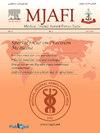Comparison of intralesional bleomycin versus salicylic acid 16.5% and lactic acid 16.5% combination paint in management of plantar warts
Q2 Medicine
引用次数: 0
Abstract
Background
Salicylic and lactic acid (SAL) paint is commonly used to treat warts due to ease of application without any instrumentation. Intralesional bleomycin has been used for the treatment of warts since the 1970s with high efficacy even at low concentration. The aim of this study was to assess the efficacy of single dose of intralesional bleomycin in the treatment of plantar warts in comparison with a control group of similar sample receiving SAL paint application.
Methods
Patients were randomly divided into two groups to receive either single dose of intralesional bleomycin injection or SAL paint application daily for maximum of two months. Plantar warts of the patients were assessed at baseline and with each return visit including a post-treatment follow-up of six months.
Results
Of the 100 patients enrolled in the study, 50 (50%) patients were treated with intralesional bleomycin, and 50 (50%) were treated with SAL paint. Out of total 441 treated warts in 100 patients, 198 (44.89%) warts were treated with intralesional bleomycin, and 243 (55.1%) warts were treated with SAL paint. The clearance rates in the context of number of patients and number of warts were 94% (47 out of 50) and 97.97% (194 out of 198) for bleomycin and 36% (18 out of 50) and 27.5% (67 out of 243) for SAL paint, respectively.
Conclusion
Single dose of intralesional bleomycin injection is significantly more effective than SAL paint for the treatment of plantar warts.
博莱霉素与16.5%水杨酸和16.5%乳酸复合涂料治疗足底疣的比较
背景:水杨酸和乳酸(SAL)涂料通常用于治疗疣,因为它易于应用,不需要任何仪器。自20世纪70年代以来,病灶内博来霉素一直用于治疗疣,即使在低浓度下也有很高的疗效。本研究的目的是评估单剂量局部内博来霉素治疗足底疣的疗效,并与接受SAL涂料应用的对照组进行比较。方法将患者随机分为两组,分别给予单次病灶内博来霉素注射或SAL涂料涂敷,疗程不超过2个月。患者的足底疣在基线和每次回访时进行评估,包括治疗后六个月的随访。结果纳入研究的100例患者中,50例(50%)患者接受病灶内博来霉素治疗,50例(50%)患者接受SAL涂料治疗。在100例接受治疗的441例疣中,198例(44.89%)疣用病变内博来霉素治疗,243例(55.1%)疣用SAL涂料治疗。博莱霉素的清除率分别为94%(47 / 50)和97.97% (194 / 198),SAL涂料的清除率分别为36%(18 / 50)和27.5%(67 / 243)。结论单次局部注射博来霉素治疗足底疣的疗效明显优于SAL涂料。
本文章由计算机程序翻译,如有差异,请以英文原文为准。
求助全文
约1分钟内获得全文
求助全文
来源期刊

Medical Journal Armed Forces India
Medicine-Medicine (all)
CiteScore
3.40
自引率
0.00%
发文量
206
期刊介绍:
This journal was conceived in 1945 as the Journal of Indian Army Medical Corps. Col DR Thapar was the first Editor who published it on behalf of Lt. Gen Gordon Wilson, the then Director of Medical Services in India. Over the years the journal has achieved various milestones. Presently it is published in Vancouver style, printed on offset, and has a distribution exceeding 5000 per issue. It is published in January, April, July and October each year.
 求助内容:
求助内容: 应助结果提醒方式:
应助结果提醒方式:


